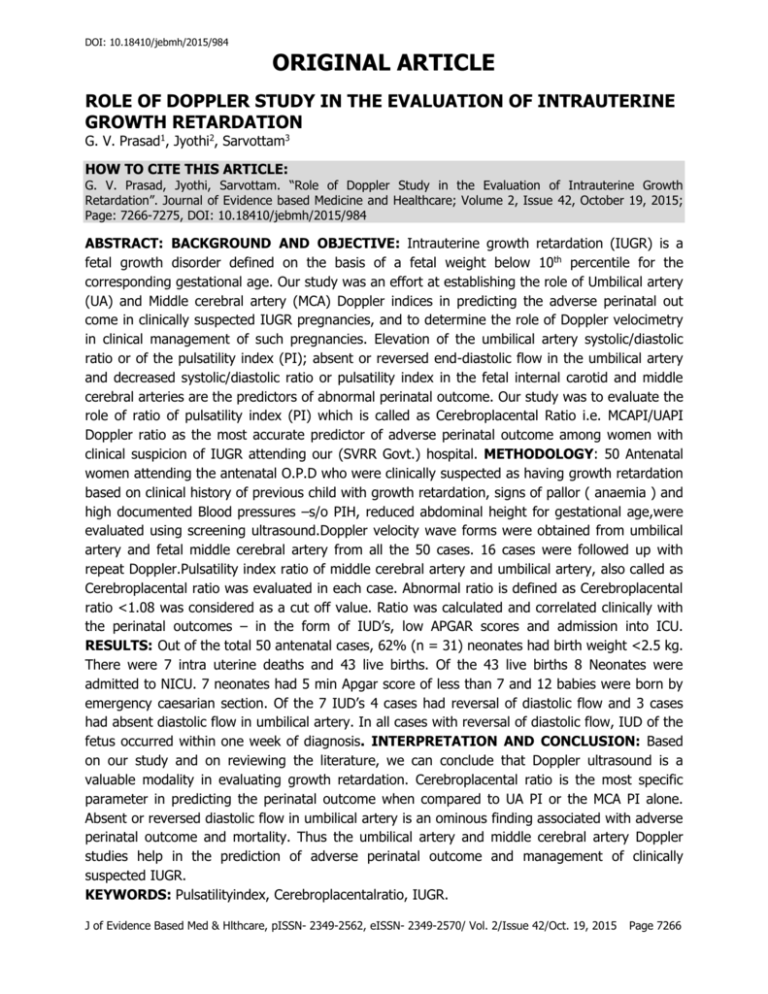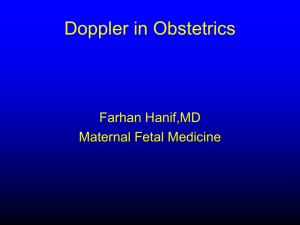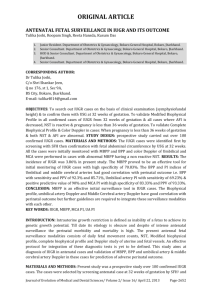GV Prasad 1 , Jyothi 2 , Sarvottam 3
advertisement

DOI: 10.18410/jebmh/2015/984 ORIGINAL ARTICLE ROLE OF DOPPLER STUDY IN THE EVALUATION OF INTRAUTERINE GROWTH RETARDATION G. V. Prasad1, Jyothi2, Sarvottam3 HOW TO CITE THIS ARTICLE: G. V. Prasad, Jyothi, Sarvottam. “Role of Doppler Study in the Evaluation of Intrauterine Growth Retardation”. Journal of Evidence based Medicine and Healthcare; Volume 2, Issue 42, October 19, 2015; Page: 7266-7275, DOI: 10.18410/jebmh/2015/984 ABSTRACT: BACKGROUND AND OBJECTIVE: Intrauterine growth retardation (IUGR) is a fetal growth disorder defined on the basis of a fetal weight below 10th percentile for the corresponding gestational age. Our study was an effort at establishing the role of Umbilical artery (UA) and Middle cerebral artery (MCA) Doppler indices in predicting the adverse perinatal out come in clinically suspected IUGR pregnancies, and to determine the role of Doppler velocimetry in clinical management of such pregnancies. Elevation of the umbilical artery systolic/diastolic ratio or of the pulsatility index (PI); absent or reversed end-diastolic flow in the umbilical artery and decreased systolic/diastolic ratio or pulsatility index in the fetal internal carotid and middle cerebral arteries are the predictors of abnormal perinatal outcome. Our study was to evaluate the role of ratio of pulsatility index (PI) which is called as Cerebroplacental Ratio i.e. MCAPI/UAPI Doppler ratio as the most accurate predictor of adverse perinatal outcome among women with clinical suspicion of IUGR attending our (SVRR Govt.) hospital. METHODOLOGY: 50 Antenatal women attending the antenatal O.P.D who were clinically suspected as having growth retardation based on clinical history of previous child with growth retardation, signs of pallor ( anaemia ) and high documented Blood pressures –s/o PIH, reduced abdominal height for gestational age,were evaluated using screening ultrasound.Doppler velocity wave forms were obtained from umbilical artery and fetal middle cerebral artery from all the 50 cases. 16 cases were followed up with repeat Doppler.Pulsatility index ratio of middle cerebral artery and umbilical artery, also called as Cerebroplacental ratio was evaluated in each case. Abnormal ratio is defined as Cerebroplacental ratio <1.08 was considered as a cut off value. Ratio was calculated and correlated clinically with the perinatal outcomes – in the form of IUD’s, low APGAR scores and admission into ICU. RESULTS: Out of the total 50 antenatal cases, 62% (n = 31) neonates had birth weight <2.5 kg. There were 7 intra uterine deaths and 43 live births. Of the 43 live births 8 Neonates were admitted to NICU. 7 neonates had 5 min Apgar score of less than 7 and 12 babies were born by emergency caesarian section. Of the 7 IUD’s 4 cases had reversal of diastolic flow and 3 cases had absent diastolic flow in umbilical artery. In all cases with reversal of diastolic flow, IUD of the fetus occurred within one week of diagnosis. INTERPRETATION AND CONCLUSION: Based on our study and on reviewing the literature, we can conclude that Doppler ultrasound is a valuable modality in evaluating growth retardation. Cerebroplacental ratio is the most specific parameter in predicting the perinatal outcome when compared to UA PI or the MCA PI alone. Absent or reversed diastolic flow in umbilical artery is an ominous finding associated with adverse perinatal outcome and mortality. Thus the umbilical artery and middle cerebral artery Doppler studies help in the prediction of adverse perinatal outcome and management of clinically suspected IUGR. KEYWORDS: Pulsatilityindex, Cerebroplacentalratio, IUGR. J of Evidence Based Med & Hlthcare, pISSN- 2349-2562, eISSN- 2349-2570/ Vol. 2/Issue 42/Oct. 19, 2015 Page 7266 DOI: 10.18410/jebmh/2015/984 ORIGINAL ARTICLE INTRODUCTION: Intrauterine growth retardation (IUGR) is a common complication of pregnancy associated with an increased risk of perinatal mortality, morbidity, and impaired neurodevelopment. Before the advent of ultrasound, assessment of fetal growth during pregnancy was limited to measuring the uterine size, assessing the fetal size by palpation and looking at the infant after delivery. Now, in the present era of Doppler sonography, diagnosis of intrauterine growth restriction has become easier and thus decreasing the perinatal mortality and morbidity rate. The incidenceof IUGRin a population wherethe mothers are generally healthy and well-nourished is estimated to be about 3-5%. In a population of women with hypertension or previous growth restricted fetus however the incidence increases to 15-20% or higher. The incidence of IUGR varies from region to region and even in thesame region, it varies in different sub populations. In India, according to recent UNICEF surveys, the incidence of IUGR is 25-30%. Doppler ultrasound allows a noninvasive assessment of fetal hemodynamics. The growing availability of Doppler equipment in the mid to late 1980s led to an outpouring of studies examining the use of this technique in pregnant women. The rationale for suspecting that Doppler imaging may be a useful diagnostic technique for IUGR is based on a chain of reasoning: 1. some cases of growth retardation are due to abnormalities of placental circulation; 2. these placental abnormalities may lead to increased resistance to blood flow in the placenta; 3. increased resistance leads to decreased velocity in the feeding arteries, especially during diastole, and this in turn leads to decreased volume of blood flow through the placenta; 4. Disproportionate slowing of diastolic relative to systolic flow leads to elevation of a number of Doppler indices, including the systolic/diastolic ratio and the pulsatility index. As Doppler ultrasound provides a unique, non-invasive and safe method of studying blood flow Characteristics in both the Fetoplacental and uteroplacental circulations, it is being used in Clinical evaluation of high risk pregnancies. Umbilical arterial (UA) Doppler velocimetry is the most evaluated test among noninvasive tests of fetal well-being. A low end-diastolic velocity in umbilical artery as a consequence of high flow resistance in capillaries of terminal villi. In response to prolonged fetal hypoxic stress, circulatory adaptation occurs, resulting in redistribution of the cardiac output to provide a constant supply of oxygen to brain and other essentialorgans (i.e heart and adrenal glands). This compensatory adjustment on which brain sparing effect is based, is associated with a rise in diastolic velocities in Doppler cerebral artery waveforms. This rise is considered a manifestation of cerebral vasodilatation, causing a decrease in Doppler indices such as pulsatility index. In majority of severely growth retarded fetuses, sequential deterioration of arterial and venous Doppler precedes biophysical score deterioration. At least one third of fetuses show early signs of circulatory deregulation oneweek before biophysical profile deterioration, and in most cases, Doppler deterioration precedes biophysical profile deterioration by 1 day. This indicates the significance of Doppler study in these patients for early detection of fetal compromise. At cordocentesis, a significant correlation has been observed between hypoxemia in fetuses with IUGR. J of Evidence Based Med & Hlthcare, pISSN- 2349-2562, eISSN- 2349-2570/ Vol. 2/Issue 42/Oct. 19, 2015 Page 7267 DOI: 10.18410/jebmh/2015/984 ORIGINAL ARTICLE Our study was an effort to establish the role of Doppler indices, especially the MCAPI/UAPI Doppler ratio as the most accurate predictor of adverse perinatal outcome among women with clinical suspicion of IUGR attending our hospital and an abnormal MCA pulsatilityindex. AIMS AND OBJECTIVES: 1. To establish the role of umbilical artery and middle cerebral artery Doppler indices in diagnosing IUGR. 2. To evaluate the usefulness of umbilical artery and middle cerebral artery as predictors of adverse perinatal out come in clinically suspected IUGR Pregnancies. 3. To establish the Role of Doppler Ultrasound in the Management of IUGR pregnancy. METHODLOGY: Present study: Hospital based cross-sectional observational study conducted in the department of Radio diagnosis, S.V.R.R G.G Hospital Tirupati. This study was proved by the Ethical Committee of our institution. Source of Data: Data for the study was collected from pregnant women clinically suspected to have IUGR, referred to the department of radio diagnosis, S.V.R.R.G.G Hospital attached to S.V Medical College. Size of the Data: The study included 50 singleton pregnancies. Inclusion Criteria: (a) Singleton pregnancy. (b) Fetal gestational age of 30 to 40 weeks with clinically suspected intrauterine growth retardation. Exclusion criteria for the study included any pregnancy with a) Documented major congenital abnormality b) Multiple gestations. Method of Collection of Data: Doppler US evaluation was performed following a detailed clinical history, US biometry, and assessment of amniotic fluid and placental maturity. Repeat Doppler studies were performed if clinically indicated to determine a favorable or a worsening trend in the Doppler indices. The results of the first Doppler ultrasound were used for analysis of perinatal outcome. Doppler US Technique: The patients were evaluated on ESOATE MY LAB 50 color Doppler ultrasound scanner with a curvilinear transducer, having a variable frequency of 3.5–5.0 MHZ. The Doppler wall filter was set at 50–100 Hz. Patients’ consent was taken in the prescribed form as per PNDT Act. PHYSICS OF DOPPLER ULTRASONOGRAPHY: The Doppler Effect is defined as a change in the perceived frequency of sound emitted by a moving source. This effect was first described by Christian Doppler in 1843. When the frequency of the emitted and received sound, and its insonation angle are known, the Doppler shift can be calculated (that is the difference between the emitted and the J of Evidence Based Med & Hlthcare, pISSN- 2349-2562, eISSN- 2349-2570/ Vol. 2/Issue 42/Oct. 19, 2015 Page 7268 DOI: 10.18410/jebmh/2015/984 ORIGINAL ARTICLE reflecting frequency), as it is correlated to the velocity of the relative movement between the target and transducer. This relation is defined by the formula. Where FD is the Doppler shift, Fo is the frequency of the transmitted ultrasound, Fr is the received frequency. V is the velocity of the relative movement, θ is the angle of insonation and C is the velocity of sound with in the tissue.37 Continuous Wave Doppler Ultrasonography: - The sound beam is continuously emitted from one transducer and received by a second. Color flow imaging (CFI): In this technique color is assigned to show direction. Customarily flow towards the Doppler transducer is displayed in red, and flow away from it is shown in blue. The structures that do not move are presented in basic gray scale image. The color saturation is related to the magnitude of the frequency shift. Color Doppler energy (CDE) detects the energy of Doppler signals generated from moving blood. The information obtained is different from that of conventional CDI. The most distinctive feature of CDE is that it is independent of direction of flow. Doppler Velocimetry: Semi Quantitative Assessment: Here the relationship between the systolic and diastolic components of the wave form is evaluated, and the angle dependence, which is important in quantitative measurements become less important. Different indices have been proposed to define the properties of the Doppler spectrum the most common in obstetric application being the pulsatility index, the resistance index and the Systolic/Diastolic(S/D) ratio. Where S is the maximum peak systolic frequency, D is the end diastolic frequency and A is the mean Doppler shift frequency during a cardiac cycle. PULSATALITY INDICES FOR GESTATIONAL AGE: The normal range is shown in 5th, 50th and 95th percentiles. J of Evidence Based Med & Hlthcare, pISSN- 2349-2562, eISSN- 2349-2570/ Vol. 2/Issue 42/Oct. 19, 2015 Page 7269 DOI: 10.18410/jebmh/2015/984 ORIGINAL ARTICLE The UA Pulsatility index ratios were considered abnormal if the value was above the 95th percentile for gestational age. The MCA pulsatilityindex was considered abnormal if the value was below the 5th percentile for gestational age. The MCA/UA PI ratio (cerebro-placental ratio) is usually constant during the last 10 weeks of gestation. It is possible to use a single cut off value after 30th week because cerebral-umbilical Doppler ratio does not vary significantly between 30th and 40th weeks. Therefore, in our study a single cutoff value (1.08) was used, above which velocimetry was considered normal and below which it was considered abnormal. The sensitivity, specificity, positive predictive value, negative predictive Value and diagnostic accuracy were determined for all Doppler measurements. CASES: Case 1: G3P2L1D1 with severe PIH with suspected IUGR. J of Evidence Based Med & Hlthcare, pISSN- 2349-2562, eISSN- 2349-2570/ Vol. 2/Issue 42/Oct. 19, 2015 Page 7270 DOI: 10.18410/jebmh/2015/984 ORIGINAL ARTICLE UMBILICAL ARTERY MCA: Decreased diastolic flow noted in Umbilical artery (increased PI value 2.9).MCA Doppler shows (decreased PI value 1.0). Cerebroplacental Ratio: 0.34 (abnormal). The child postnatally had low APGAR -4 and was admitted to ICU. Case 2: 22yr old G2P1L1 with severe PIH. Reversal of diastolic flow within umbilical artery showing (high PI value 2.2). Similarly MCA shows decreased PI value 1.1. Cerebroplacental ratio: 0.5 (abnormal).There was IUD of the fetus within 48 hours as the patient refused admission. OBSERVATION AND RESULTS: GESTATIONAL AGE NUMBER PERCENTAGE 30-32 21 42% 33-35 12 24% 36-40 17 34% TOTAL 50 100% MEAN+/-2SD 33.66+/-2.46 Gestational age distribution in the study group PARITY NO. OF CASES PERCENTAGE Primigravida 32 54% Multigravida 18 36% Parity distribution among the study group Maternal complications of the study group: 60% (n=30) of the mothers had Pregnancy Induced Hypertension, 20 % (n=10) had anemia, 8 %( n=4) patients had diagnosed chronic kidney disease, 12 %( n=6) had PIH associated with anemia at first Doppler examination. Amniotic Fluid Distribution in the Study Group: 30% (n=15) had normal liquor and 70% (n=35) had Oligohydramnios at first Doppler examination. J of Evidence Based Med & Hlthcare, pISSN- 2349-2562, eISSN- 2349-2570/ Vol. 2/Issue 42/Oct. 19, 2015 Page 7271 DOI: 10.18410/jebmh/2015/984 ORIGINAL ARTICLE Distribution Characteristics of Placental Maturity: 72% of cases (n=36) had Grade III Placental maturity at the time of first Doppler Examination and 28 %( n=14) had Grade II; Placental maturity. Distribution of PI Values among the study group: Patients with abnormal PI values in Umbilical artery (value above 95th percentile and low PI value in MCA (less than 5th percentile) had a subnormal clinical outcome. ADVERSE OUTCOME NO. OF CASES PERCENTAGE Intrauterine deaths 7 20% Emergency CS 12 34.28% Low Apgar score 8 22.85% Admission to NICU 8 22.85% Adverse Fetal Outcomes Of the 7 IUDs 4 cases had reversal of diastolic flow and 3 had absent diastolic flow. In all cases with reversal of diastolic flow, IUD of the fetus occurred within one week of diagnosis – S/o 100% mortality and all the 4 cases were less than 32 weeks. TP- true positives; TN –true negatives; FP-false positives; FN-false negatives. J of Evidence Based Med & Hlthcare, pISSN- 2349-2562, eISSN- 2349-2570/ Vol. 2/Issue 42/Oct. 19, 2015 Page 7272 DOI: 10.18410/jebmh/2015/984 ORIGINAL ARTICLE 26 20 4 5 7 13 13 11 86.6% 76% 80 % 78% Diagnostic Accuracy 78% 52% 27 8 4 16 90% 88% 86% Doppler index TP TN FP FN Sensitivity Specificity UA PI MCA PI MCAPI/UAPI RATIO Performance Characteristics of Doppler Indices Doppler index Diagnostic accuracy UA PI 78% MCA PI 62% MCA/UA PI Ratio (Cerebroplacental Ratio) 86% Table showing Diagnostic accuracies of Doppler Indices DISCUSSION: Doppler velocimetry is a noninvasive technique that evaluates the abnormal fetalhemodynamics that take place in response to changes in placental resistance. A Doppler index that reflects these changes can be useful in identifying the fetuses with increased placental and decreased cerebral resistance. We chose incidences of perinatal death, emergency section for fetal distress, NICU admission for complication of low birth weight and low Apgar score as outcome variables in concurrence with previous studies done. Cerebro-placental ratio has a high sensitivity, specificity and diagnostic accuracy in predicting adverse perinatal outcome. Our results in evaluating the usefulness of umbilical and middle cerebral artery Doppler in predicting the adverse perinatal outcome in IUGR indicate that both abnormal umbilical Doppler indices and cerebro-placental ratio are strong predictors of adverse outcome in IUGR. MCA PI is not a reliable indicator when used alone. The combination of umbilical and middle cerebral Doppler indices may increase the utility of Doppler ultrasound in clinically suspected IUGR. CONCLUSION: 1. Doppler Ultrasound is a valuable initial modality for the evaluation of patients. With suspected intrauterine growth retardation. 2. Doppler evaluation of umbilical and middle cerebral arteries has an important role in the early diagnosis of clinically suspected growth retardation. 3. Abnormal Cerebroplacental ratio, in particular is a strong predictor of adverse perinatal outcome in IUGR. 4. Umbilical artery Doppler is more useful than middle cerebral artery in Prediction of outcome in IUGR when considered individually. J of Evidence Based Med & Hlthcare, pISSN- 2349-2562, eISSN- 2349-2570/ Vol. 2/Issue 42/Oct. 19, 2015 Page 7273 DOI: 10.18410/jebmh/2015/984 ORIGINAL ARTICLE 5. Umbilical artery Doppler is more useful than middle cerebral artery in prediction of outcome in IUGR when considered individually. 6. Absent and reversed diastolic flow in umbilical artery in IUGR is an ominous finding associated with increased mortality and morbidity. Fetal Doppler study plays a significant role in the management of growth restricted fetuses by early identification of compromised fetuses and thus determine the line of management. Thus fetal Doppler study should be an integral part in evaluation of a suspected IUGR pregnancy, diagnosingand predicting the adverse outcome BIBLIOGRAPHY: 1. Doubilet PM, Benson CB. Fetal growth disturbances. Semin Roentgenol 1990; 15: 309-316 2. Zimmer EZ, Divon MY. Sonographic diagnosis of IUGR and macrosomia. C/in Obstetric Gynecol 1992; 35: 172-1 84. 3. Dobson PC, Abell DA, Beischer NA. Mortality and morbidity of fetal growth retardation. Aust N Z J Obstet Gynecol 1981; 21: 69-72. 4. Gilbert WM, Danielson B. Pregnancy outcomes associated with intrauterine growth restriction. Am J Obstet Gynecol 2003; 188: 1596–1599. 5. Galbraith RS, Kershmar EJ, Peircy WN, Low JA. The clinical prediction of intrauterine growth retardation. Am J Obstet Gynecol 1979; 133: 281-286. 6. Devi PIC, Krishna menon MK, Bhaskar Rao K. Postgraduate obstetrics and gynecology. Orient long man; 3rdEdn 1986: 219. 7. Dane C, Harrington K. A practical approach to obtaining optimum Doppler signals. In: Harrington K, Campbell S, editors. A color atlas of Doppler ultrasonography in obstetrics. London Arnold, 1995: 35-46. 8. Kok JH, den Ouden AL, Verloove-Vanhorick SP, Brand R. Outcome of very preterm small for gestational age infants: the first nine years of life. Br J Obstet Gynaecol 1998; 105:162-168. 9. Peeters LH, Sheldon RE, Jones MD, et al. Blood flow to fetal organs as a function of arterial oxygen content. Am J Obstet Gynecol 1979; 135: 637-646. 10. Campbell S. Fetal growth. In: nathanietz P, Beard R, eds. Fetal physiology and medicine Bournemouth, United Kingdom; Saunders, 1974: 271-300. 11. Arbillie PH, Ronsin A, Berson M, Pourcelot L. exploration of fetal cerebral blood flow by duplex Doppler linear array system in normal and pathological pregnancies. Ultrasound Med Biol 1987; 13: 329-32. 12. Waldimiroff J. W, Wijingaard JAGW, Deganis, Noordam MJ, Eyck J, Tonge HM. Cerebral and umbilical arterial blood flow velocity waveforms in normal and growth restricted pregnancies. Obstet Gynaecol 1987; 69: 705-9. 13. Gramellini D, Folli MC, Raboni S, Vadora E, Merialdi A. Cerebral-umbilical Doppler ratio as a predictor of adverse perinatal outcome. Obstet Gynecol 1992; 79: 416-420. 14. Arias F. Accuracy of the middle-cerebral-to-umbilical-artery resistance index ratio in the prediction of neonatal outcome in patients at high risk for fetal and neonatal complications. Am J Obstet Gynecol 1994; 171: 1541-1545. J of Evidence Based Med & Hlthcare, pISSN- 2349-2562, eISSN- 2349-2570/ Vol. 2/Issue 42/Oct. 19, 2015 Page 7274 DOI: 10.18410/jebmh/2015/984 ORIGINAL ARTICLE 15. Vyas S, Nicolaides KH, Bower S, et al. Middle cerebral artery flow velocity waveforms in fetal hypoxemia. Br J Obstet Gynaecol 1990; 97: 797-803. 16. Campbell S, Vyas S, Nicolaides KH. Doppler investigation of the fetal circulation. J. Perinat Med. 1991; 19(1-2): 21-6. 17. Arduini D, Rizzo G. Prediction of fetal outcome in small for gestational age fetus: comparison of Doppler measurements obtained from different fetal vessels. J Perinat Med 1992; 20: 29-38. 18. Karsdorp VH, van Vugt JM, van Geijn HP, Kostense PJ, Arduini D, Montenegro N, Clinical significance of absent or reversed end diastolic velocity waveforms in umbilical artery. Lancet. 1994 Dec 17; 344(8938): 1664-8. 19. Harrington K, Carpenter RG, Nguyen M, et al. Changes observed in Doppler studies of fetal circulation in pregnancies complicated by pre-eclampsia or the delivery of small-forgestational age baby. I. Cross-sectional analysis. Ultrasound Obstet and Gynecol 1995; 69(1): 19-28. 20. Chan FY, Pun TC, Lam P, Lam C, Lee CP, Lam YH. Fetal cerebral Doppler as a predictor of perinatal outcome and subsequent neurological handicap. Obstet Gynecol 1996; 87: 981988. 21. P. Arbeille. Fetal arterial Doppler-IUGR and hypoxia. Eur J Obstet Gynecol Reprod Biol 1997 December; 75(1): 51-53. 22. Berkowitz GS, Mehalek KE, Chitkara Rosenberg J, Coqswell C, Berkowitz RL, Doppler umbilical velocimetry in the prediction of adverse outcome in pregnancies at risk for intrauterine growth retardation. Obstet Gynaecol 1988; 71: 745-6. 23. Fong KW, Ohlsson A, Hannah ME, Grisaru S, Kingdom J, Ryan M, et al. Prediction of Perinatal Outcome in Fetuses Suspected to Have Intrauterine Growth Restriction: Doppler US Study of Fetal Cerebral, Renal, and Umbilical Arteries. Radiology 1999; 213: 681-689. AUTHORS: 1. G. V. Prasad 2. Jyothi 3. Sarvottam PARTICULARS OF CONTRIBUTORS: 1. Associate Professor, Department of Radiology, S. V. Medical College. 2. Resident, Department of Radiology, S. V. Medical College. 3. Resident, Department of Radiology, S. V. Medical College. NAME ADDRESS EMAIL ID OF THE CORRESPONDING AUTHOR: Dr. G. V. Prasad, Flat No. 201, V. V. Plaza, Reddy and Reddy Colony, Tirupathi-517501, Andhra Pradesh. E-mail: g_v789@yahoo.com Date Date Date Date of of of of Submission: 25/09/2015. Peer Review: 26/09/2015. Acceptance: 30/09/2015. Publishing: 14/10/2015. J of Evidence Based Med & Hlthcare, pISSN- 2349-2562, eISSN- 2349-2570/ Vol. 2/Issue 42/Oct. 19, 2015 Page 7275







